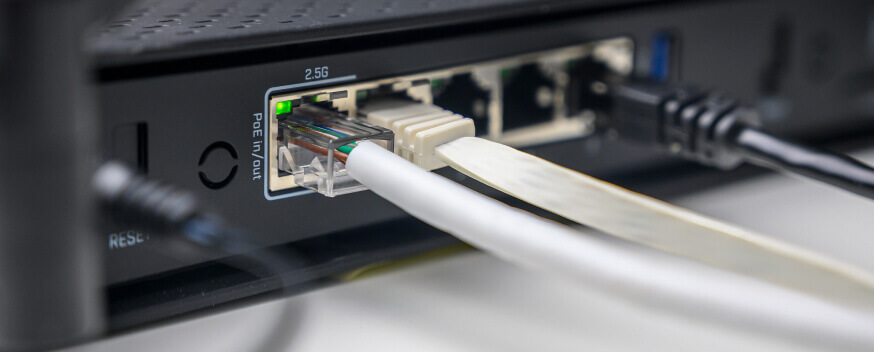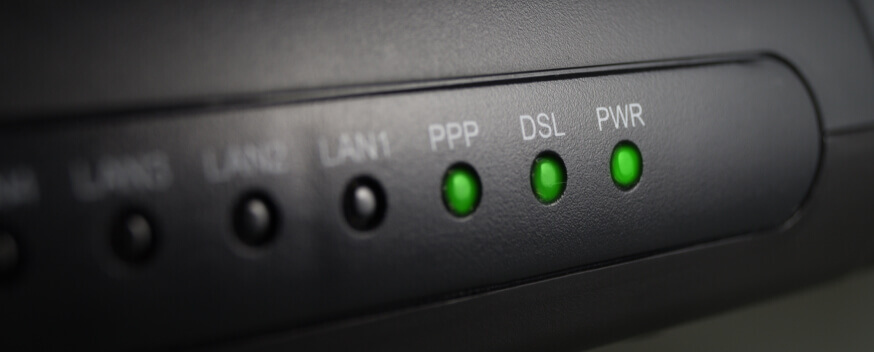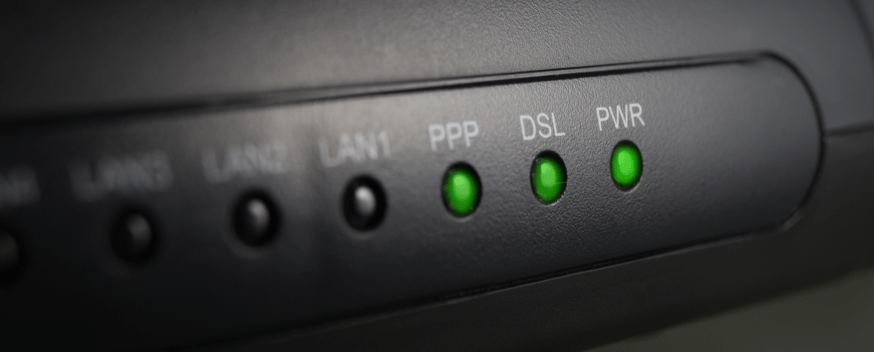If you’re a digital native, it may be hard to imagine how slow the internet was back in the 1990s.
Dial-up internet service was the rule. Back then, every telephone call to your house would throw you off the internet. It was pure crazy-making. Gen Xers remember well the high-pitched whining sounds of the dial-up modem trying to connect…and trying…and trying.
DSL internet saved the day by introducing a faster and more reliable connection. Now, DSL is one of the oldest internet technologies on the market. But it still works! And plenty of people in the USA need to use DSL because they don’t have access to other types of wired internet.
Are you choosing an internet provider or thinking about switching to a new ISP? If DSL is one of your internet options, you’ve come to the right place to learn more about it.
Here, you can explore what makes good DSL internet. You’ll find out exactly how DSL stacks up to the other internet options in your area. And this article will also name some of the best DSL Internet providers of 2024. When you’re finished reading, you’ll be well-informed and ready to choose the kind of internet that’s right for you.

What is DSL Internet?
DSL, which stands for Digital Subscriber Line, is a type of internet connection that uses existing copper telephone lines to transmit data. DSL provides a reliable and stable connection by using a different frequency range than traditional voice calls. DSL is a common internet choice for many households because it is available in so many places that don’t have cable or fiber internet service.
Some internet companies also call DSL-based service by a different name, “Internet Protocol Broadband,” or IPBB. IPBB usually refers to a DSL network that uses updated technology and some fiber-optic lines to deliver better DSL service.
PROS
CONS
DSL Internet vs. Other Types of Internet Connection
DSL vs. Dial-Up
DSL continues to be much faster than dial-up. Dial-up moves at a snail’s pace for today’s internet standards, but DSL can often keep up with broadband speeds. On the whole, dial-up is the least desirable internet choice of all. DSL will always give you better performance than dial-up. Dial-up is so slow that any alternative would be preferable to dial-up, including satellite internet or fixed wireless internet.
DSL vs. Cable
DSL generally offers slower speeds compared to cable internet. Though a few DSL connections can get up to 100 Mbps download speed, they are rare. 10-40 Mbps is much more common. Cable internet, by contrast, often provides download speeds up to 300, 500, or even 1000 Mbps. DSL does avoid network congestion issues, but in general, a cable internet connection will offer better performance. In many cases, DSL and cable internet will cost about the same, but you will get much higher speeds from cable for the price.
DSL vs. Fiber-optic
Fiber-optic internet is currently the fastest and most reliable internet option available, offering much higher speeds than DSL. Fiber internet also offers symmetrical upload and download speeds. And fiber internet will also usually be much cheaper than DSL for the speeds you get from each. For example, you might pay $50/month to get 25 Mbps download from DSL, but you would get 200 Mbps download *and* upload speeds from a similar fiber plan. However, despite DSL’s slower speeds, DSL performs valuable work by connecting many rural areas and small towns to the digital world. DSL can provide reliable home internet in these areas that lack cable or fiber.
DSL vs. Satellite
Satellite internet is a good option for those in remote areas where other types of connections are not available. Satellite offers nationwide coverage to any household with a clear view of the southern sky. But satellite internet can be affected by weather conditions and typically comes with higher latency compared to DSL. The choice between DSL and satellite is often the most complex because of the wide variations in DSL speeds. Make sure that if you are making this choice, you get a really accurate picture of the speeds you would get from each technology. Some satellite internet connections are faster and more reliable than very slow DSL.

Understanding DSL Speeds and Pricing
DSL is different from most other types of internet connection because the speeds depend so heavily on factors that ISPs can’t always control. For example, the age and quality of the wiring inside your home and in your neighborhood will heavily influence your maximum speed. How far your home is from the network hub will also affect your speed.
This is important because unlike many other ISPs, DSL providers don’t usually try to sell you a range of different speeds at differing prices. Instead, they usually offer you the fastest speed they think your home can support, whether that’s 12 Mbps or 75 Mbps download. And frequently, no matter what your actual speed, your DSL price will be about the same. So, you will pay about $50 for DSL, in many cases, whether it’s faster or slower. You can see that DSL internet uses a very different pricing model from fiber or cable.

Top DSL Internet Providers
If DSL is available in your area, you’ll want to know which are the top DSL providers in 2024. These providers offer reliable DSL internet services with varying speeds, plans, and customer support.
Best DSL Internet Providers
AT&T Internet is one of the leading DSL providers in the United States, matching its similar strength in the fiber internet market.
AT&T offers IPBB, which gives you a blend of copper DSL service and fiber-optic cables. If you get IPBB, you are likely to have a better range of speeds than your speed with a more copper-based DSL network.
One of the strengths of AT&T Internet is that the company divides internet service into a large number of speed tiers[5]. Because of this precision, it may be easier for you to get an accurate idea of what speeds your DSL/IPBB will offer you. It’s easy enough to remember that AT&T Internet 25 will give you about 25 Mbps download speed and 2-5 Mbps upload speed.
Above all, AT&T will give you reliable connectivity and a large, smooth operations base across 21 states. And with AT&T, you will get strong customer support available through chat, website, or telephone 24/7.
How to Choose the Best DSL Internet Provider
Availability
National providers offer DSL services across multiple states. Enter your zip code to see which DSL providers serve your area.
Speed options
After you see the plan options, make sure that the speed package available to you is one that will meet your internet needs.
Reliability
Look for the top providers known for delivering stable and consistent connections, like the ISPs listed in this article.
Pricing and plans
Compare pricing and plans offered by different providers to find the best value for your budget. Ask yourself whether DSL is the right connection for you given what else might be available in your area.
Customer Support
Read our customer reviews and ratings to assess the quality of customer support provided by the provider.

But How Does DSL Internet Work
DSL internet works by sending data signals through existing copper telephone lines in your home. DSL uses separate frequencies to transmit data and voice signals at the same time. This technology means that you can use the internet and make phone calls from your landline simultaneously. The DSL modem installed at your home connects to your landline telephone jack.
With a DSL Internet connection, you can expect a fairly stable, reliable internet connection. Speeds will be unpredictable until you see what is available near your zip code and at your home address.
If your speed is above 25 Mbps download/3 Mbps upload, you will be able to do most common internet activities without trouble. Console gaming and videoconferencing may need more speed, especially if there are several people in your household using the internet at once. But if DSL is your only wired option, it may still be your fastest choice. You’ll have to compare satellite speeds and fixed wireless speeds to be certain, if those connections are available at your home.
DSL Internet Installation
Hooking up DSL Internet is probably the easiest type of internet installation. You may have a self-installation option available from your provider that will cost much less than a professional installation. If you do have to pay for a professional installation, it will usually cost around $50-100.
Modem setup: The provider will provide you with a DSL modem or guide you through the process of purchasing one. Set up the modem by following the provided instructions.
Connection setup: Connect the DSL modem to your telephone jack using the provided cables and filters, if necessary.
Activation and configuration: Once the physical setup is complete, the provider will activate your DSL service and guide you through any necessary configuration steps.
Frequently Asked Questions
DSL internet availability varies by region and location. Enter your zip code to see if DSL services are available in your area and get our detailed lists of plans, prices, and promotions.
While faster DSL speeds can support gaming and streaming, many DSL connections will be too slow. or Fiber internet or cable internet are usually the best choices to support gaming or HD streaming.
Yes, DSL utilizes your existing copper telephone lines to provide internet connectivity.
DSL Internet connections are generally secure. But as with any internet connection, you should use a firewall and keep your devices updated with the latest security patches.
Sources
[2] NextDoor.com
[3] Wikipedia. “Digital Subscriber Line.”
[4] Federal Communications Commission. “2015 Broadband Progress Report.”
[5] ATT.com. “DSL High-Speed Internet.”
[6] FCC National Broadband Map. “Providers: Kinetic by Windstream.”
